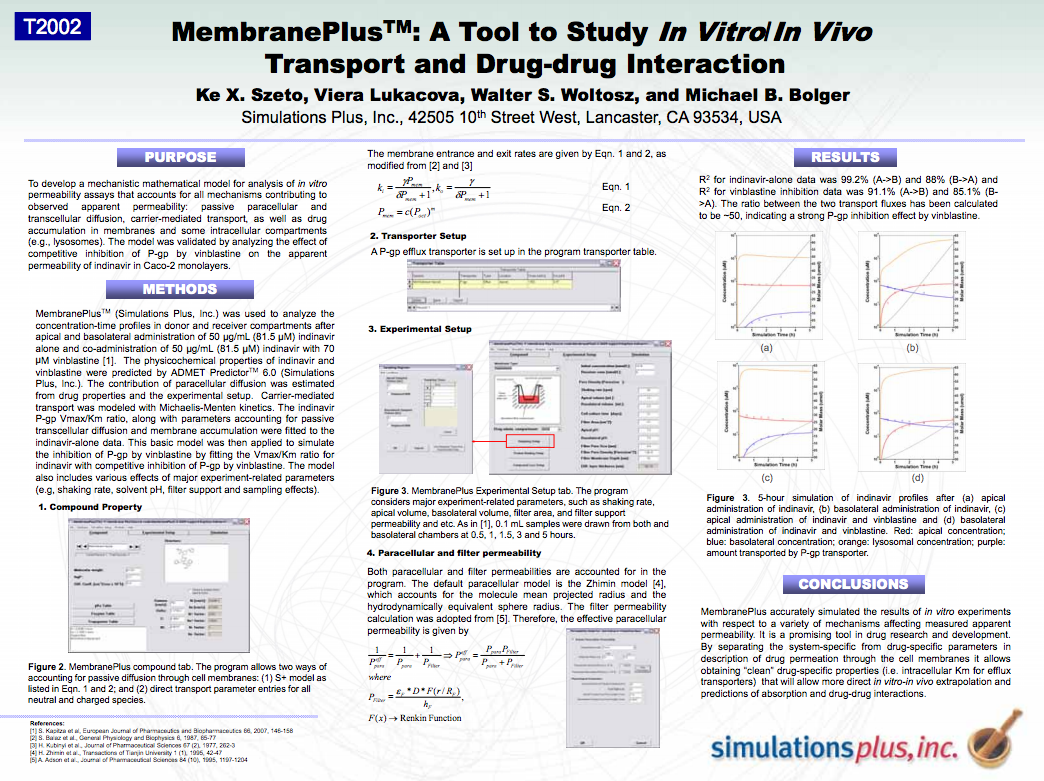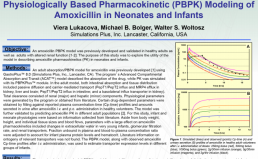TAK-875 (fasiglifam), a GPR40 agonist in development for treatment of type 2 diabetes, was voluntarily terminated in phase 3 due to adverse liver effects.

Development of Physiologically Based Pharmacokinetic (PBPK) Model for Simulating the Disposition of Antibody Drug Conjugates
Antibody- drug conjugates (ADCs) are a novel class of therapeutic agents that deliver potentcy totoxic drug molecules (payload) to their targets while reducing systemic exposure. ADCs may be composed of...

Simulation of in vitro Caco-2 Papp from Molecular Structure Estimation of Intracellular Km for Efflux Transporters
To build in silico models based on molecular structure that estimate the rate of passive diffusion into and out of the cell membrane and to combine those estimates with a cellular simulation of Caco-2...

Modeling of Cilostazol absorption and pharmacokinetics in Beagle Dogs and design of in-vitro dissolution experiment to model the in-vivo absorption
The purpose of this study was to evaluate the in-vitro/in-vivo (IVIV) correlationfor a Class II compound and to design an in-vitro dissolution experiment that improves this IVIV correlation by taking...

Modeling and Simulation Strategy to Support Eslicarbazepine Acetate (ESL) Development in Pediatric Patients in the Treatment of Partial-Onset Seizures
Eslicarbazepine acetate (ESL, Aptiom®) was FDA approved for adjunctive treatment of partial-onset seizures (POS) in adults aged 18 years and older, with subsequent approval as monotherapy.

Interactive Code for Guiding Dose Selection
Assuming a linear one-compartment model for the pharmacokinetics (PK) with and without dose-dependent saturable bioavailability, and a direct inhibitory Emax model for bio-marker effect (PD), develop an...

Pharmacokinetic-Pharmacodynamic Modeling and Simulation to Predict Efficacy Outcomes With Eslicarbazepine Acetate 800 mg Once Daily as Monotherapy for Partial-Onset Seizures
Eslicarbazepine acetate (ESL) is a once-daily (QD) oral antiepileptic drug (AED), approved as adjunctive treatment for partial-onset seizures (POS) in the USA, Europe, and Canada, and as monotherapy for POS in the USA.

Providing Insight into Novel Dosing Protocols Using a Quantitative Systems Pharmacology (QSP) Model of Drug-Induced Liver Injury
Elevations in serum alanine aminotransferase (ALT) were observed in phase I clinical studies for a novel inpatient anti-infective therapy (Compound X).

Mechanistic Modeling with Dilisym® Predicts Species Differences in CKA Via Multiple Hepatotoxicity Mechanisms
To predict species differences in CKA-mediated hepatotoxicity using DILIsym®, a mechanistic model of drug-induced liver injury (DILI)

Mechanistic Modeling of Drug-Induced Liver Injury Due to mtDNA Depletion in DILIsym®
To simulate drug-induced liver injury (DILI) due to mitochondrial DNA (mtDNA) depletion in DILIsym using Fialuridine (FIAU) as an exemplar compound.

MembranePlus™: a tool to study in vitro/in vivo transport and drug-drug interaction
MembranePlus (Simulations Plus, Inc.) was used to analyze the concentration-time profiles in donor and receiver compartments after apical and basolateral administration of 50 μg/mL (81.5 μM) indinavir alone...

Physiologically Based Pharmacokinetic (PBPK) Modeling of Amoxicillin in Neonates and Infants
An amoxicillin PBPK model was previously developed and validated in healthy adults as well as adults with altered renal function [1-2]. The purpose of this study was to explore the utility of the model...

Quantitative Estimation Of Predictive Uncertainty
The performance of QSAR models has traditionally been evaluated in terms of aggregate statistics – sensitivity, specificity, root mean square error (RMSE), R2, etc. – for some kind of test set.

Physiologically based pharmacokinetic (PBPK) model for intramuscular injection of aripiprazole
Aripiprazole is an atypical antipsychotics drug that is widely used in the treatment of agitation associated with schizophrenia, schizoaffective disorder, schizophreniform disorder or bipolar I disorder.

Relationship of Cariprazine Plasma Concentration to Efficacy and Safety in Patients With Schizophrenia or Bipolar Mania
Population exposure‑response analysis was undertaken to describe the relationship of drug concentrations to measures of clinical efficacy and safety in patients with schizophrenia or bipolar mania.

The Steady-State Pharmacokinetic Profile Across a Range of Patient Body Weight Categories Supports Weight-Based Dosing for Intravenous Reslizumab
Reslizumab is an IgG4 kappa humanized monoclonal antibody that targets interleukin-5, leading to marked reductions in airway eosinophil levels, and is indicated as an ‘add-on’ maintenance treatment for adult...

Physiologically Based Pharmacokinetic (PBPK) Model to Describe Absorption and Disposition of Inhaled Capreomycin
The current work describes the simulation of capreomycin pharmacokinetics (PK) after IV and pulmonary administration. Capreomycin is an antibiotic used to treat tuberculosis. It is eliminated mainly by...

Use of Pharmacokinetic-Pharmacodynamic Modeling and Simulations to Predict Efficacy Outcomes with Eslicarbazepine Acetate 800 mg Once Daily as Monotherapy
Eslicarbazepine acetate (ESL) is a once-daily (QD) oral antiepileptic drug (AED), approved as adjunctive treatment for partial-onset seizures (POS) in the USA, Europe, and Canada, and as monotherapy for...

Integrating Predictions from Complementary Cytochrome P450 (CYP) Models
Many structure-activity classification models have been published for predicting whether a given compound is likely to inhibit and/or be subject to metabolism by a given cytochrome P450 (CYP) isoform, and...

QSAR-based Prediction of Ames Mutagenicity for ICH M7 Submissions
The “Ames test”, originally developed by Bruce Ames and his group, is a way to measure the mutagenic potential of chemicals.1 It uses strains of Salmonella typhimurium and Escherichia coli as an...
